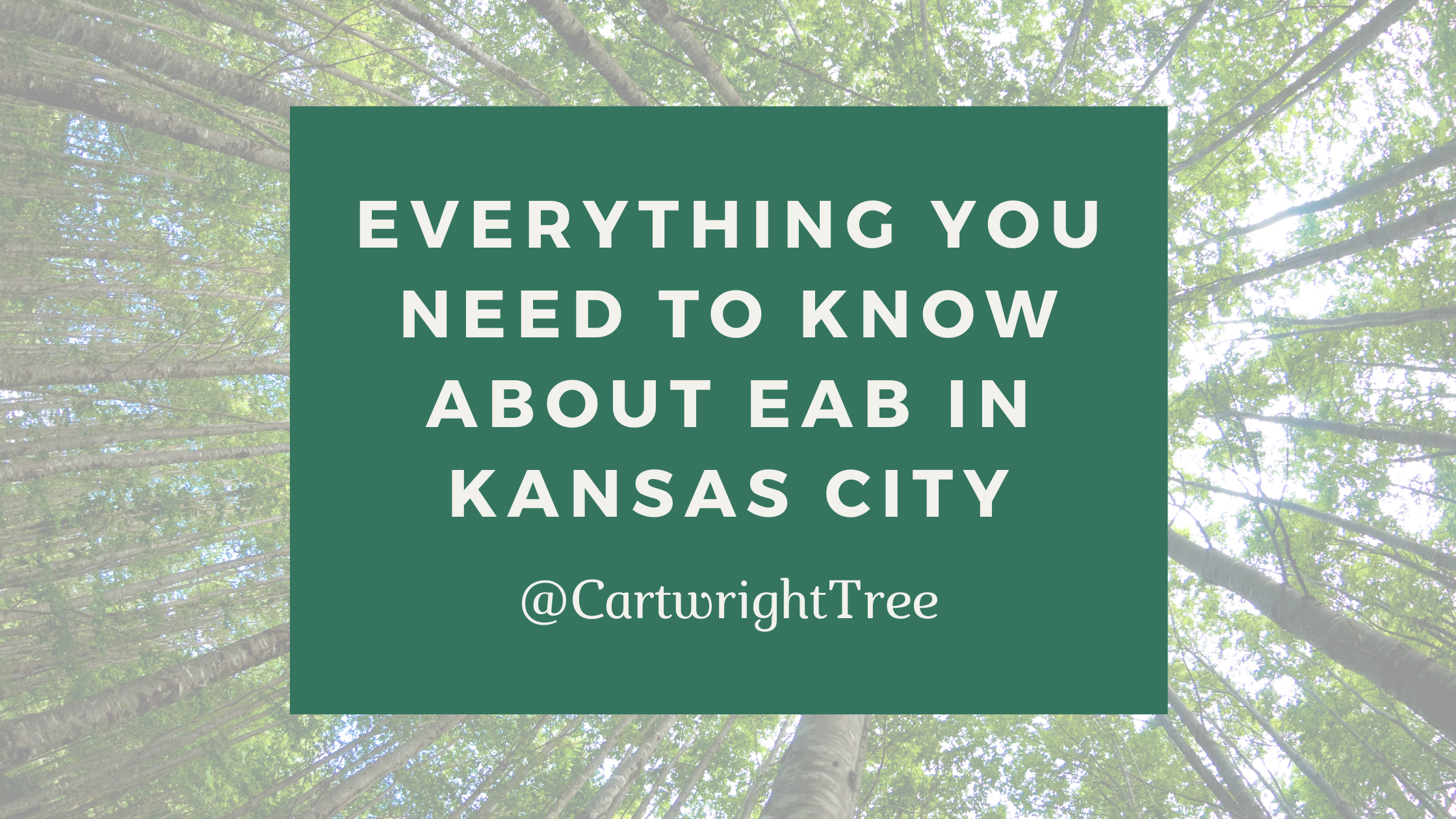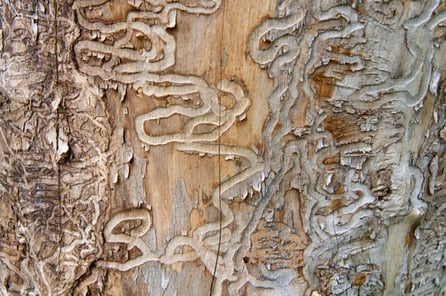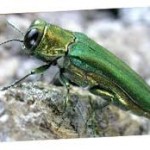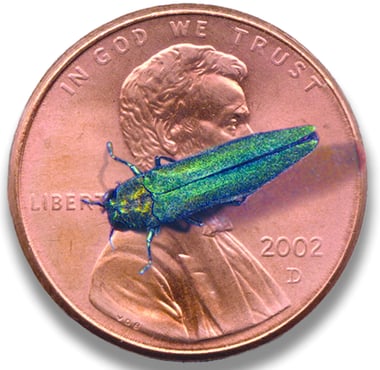
Kansas City has recently been facing a new epidemic. No, we're not talking about a new type of flu or virus. We’re talking pests here. In the past few years, the Emerald Ash Borer has become quite invasive and we are seeing more and more property owners being affected by these pests.
This crisis is causing damage to beautiful, established trees. Don’t fret though. We are going to tell you how to identify these critters and prevent damage to your trees and property.
The Emerald Ash Borer, when it comes down to it, is just a beetle. However, it has become an invasive species in North America, and both Kansas and Missouri have been affected by the Emerald Ash Borer or EAB.
The insect, which has infested trees throughout the nation, is not a threat to human or animal health but poses a risk to the region’s 4.6 million ash trees. As stated by Kansas City Parks and Rec.

So, how many ash trees are in Kansas City, Mo.? Kansas City Parks and Rec states, 20,000 ash trees are located on public property within Kansas City, Mo. and more than 400,000 ash trees are on private property. Within Greater Kansas City’s nine county region, the estimate is more than 4.6 million ash trees.
So, what is an Emerald Ash Borer? The EAB is a metallic green beetle that is about a third of an inch long when it is full grown. This beetle can usually be seen chomping on the leaves of ash trees during the day as they love the sun. They are most commonly seen from May to August as this is their peak season as adults emerge from inside the trees and begin to mate.
The Emerald Ash Borer’s overall lifespan is not long. They only live for one to two months depending on their gender. Females live longer to lay eggs naturally. Since the Emerald Ash Borer love to mate in the later afternoon and evening, they can often be seen around the base of trees in the early evening hours from June to July.
How big is EAB a problem? The EAB poses an enormous threat to our urban and rural forests. If it is not contained and managed, the impact of the beetle in North America will be similar to the devastation caused by Chestnut blight and the Dutch Elm disease. Non-native organisms, like the EAB, are more destructive than native organisms because they do not have natural population controls such as parasites, predators or diseases. Having had no previous contact with the organism, host plants have not had time to adapt and develop effective defenses against them. For perspective – Chestnut blight destroyed 500 million trees and Dutch Elm disease destroyed three billion trees. EAB has the potential to kill nine billion trees nationally.
How do I know if I have an ash tree? An ash tree has an opposite branching pattern (two branches come off the main stem, one on each side and directly opposite each other). Plus, ash trees have compound leaves with five-11 leaflets (depending on the species of ash). Leaflets are moderately toothed and may be stalked or sessile.

Are there symptoms I should look for that indicates my tree may have been attacked? Yes, if your ash tree has sparse foliage and/or dying branches in the upper part of the tree; new sprouts on the roots, lower trunk or branches; or increased woodpecker activity on the tree, these are indicators of EAB. However, these may also be symptoms the tree is stressed by other insects, disease, weather or other factors. Those symptoms outlined above by themselves do not mean the problem is Emerald Ash Borer (EAB). Please consult a certified arborist to confirm the presence of EAB. Early signs of problems can be yellowing tree leaves and damage to the upper canopy or cracked upper limbs. At this point, a pest treatment could be done to help remedy the issue. If left to progress you may need to explore more drastic action such as tree removal.
Are dying ash trees always an indication of an EAB infestation? No. Ash trees are affected by several diseases and insects. Ash trees throughout the state exhibit dying branches and/or decline. Some may show signs of heavy woodpecker damage. This may or may not be due to the EAB.
What signs are the best evidence that EAB may be attacking my tree? Look for 1/8 inch diameter D-shaped holes in the bark where the beetles have exited and short (3-5 inches) vertical splits in the bark that reveal S-shaped “trails” under the bark.
Is there anything I can do now to protect the ash trees in my yard from EAB? Keeping trees vigorous and healthy by proper pruning, mulching, watering and avoid wounding helps them resist insect attack. Avoid bringing firewood from other areas as this may also bring unwanted tree pests. Closely monitor trees for signs of EAB infestation.

What about insecticides? Should I begin to use them to protect my ash trees from EAB? Preventative insecticide applications are generally not recommended if known infestations are not within 15 miles of your location and/or found within your county. Premature use of insecticides is ineffective, wastes money and needlessly adds chemicals to the environment.
What is being done about this new pest? Many Federal, State and Municipal agencies, universities and other cooperators are working together to detect, control and prevent the human-assisted spread of EAB. Strategies to manage the pest currently focus on survey activities, panel traps, along with regulatory activities and public awareness campaigns aimed at preventing human-assisted movement of the EAB. Outreach efforts have emphasized “Don’t Move Firewood,” as firewood movement is the primary method of artificial spread of this pest. Research also continues to identify effective new tools for managing and controlling EAB populations.
Next Step! If you see a green metallic beetle around your Ash trees or near cracks in the trunk, seek out a certified arborist as soon as you can and have them inspect the affected tree. Emerald Ash Borers can take a while to completely damage a tree, so it is possible to catch and correct the issue.
So, if you are in the Kansas City metro area, keep your eye out. If you see signs of the Emerald Ash Borer on your property or lawn, give Cartwright Tree Care a call and have one of our professional arborists help to investigate the issue and provide a plan of action.
Sources:
- “Biology of Emerald Ash Borer - Invasive Species - Forest Disturbance Processes - Northern Research Station - USDA Forest Service.” Effects of Emerald Ash Borer on Forest Ecosystems - Emerald Ash Borer - Forest Disturbance Processes - Northern Research Station - USDA Forest Service, www.nrs.fs.fed.us/disturbance/invasive_species/eab/biology_ecology/planipennis/.
- "Kansas City Parks & Rec - Emerald Ash Borer Information, https://kcparks.org/services/emerald-ash-borer/

